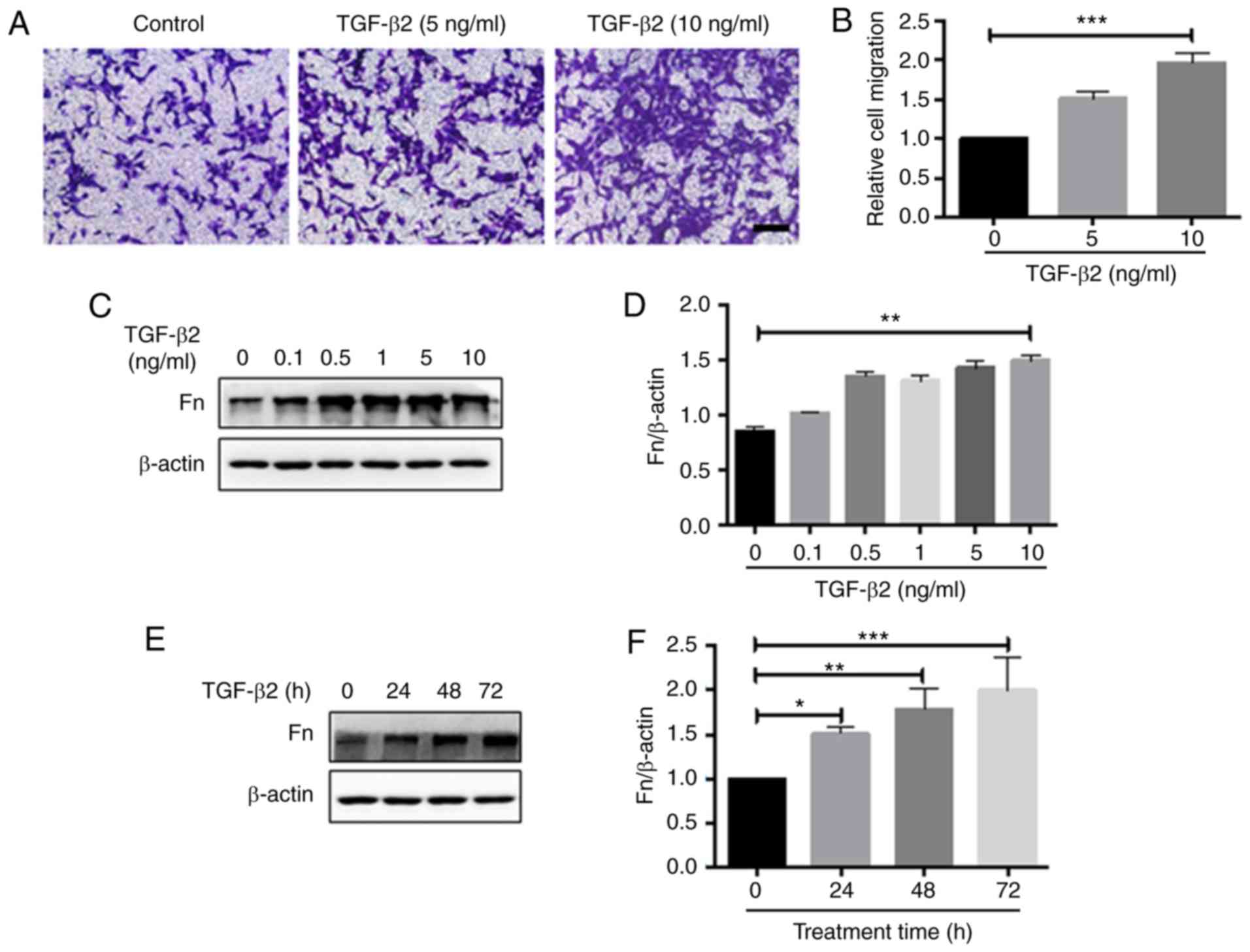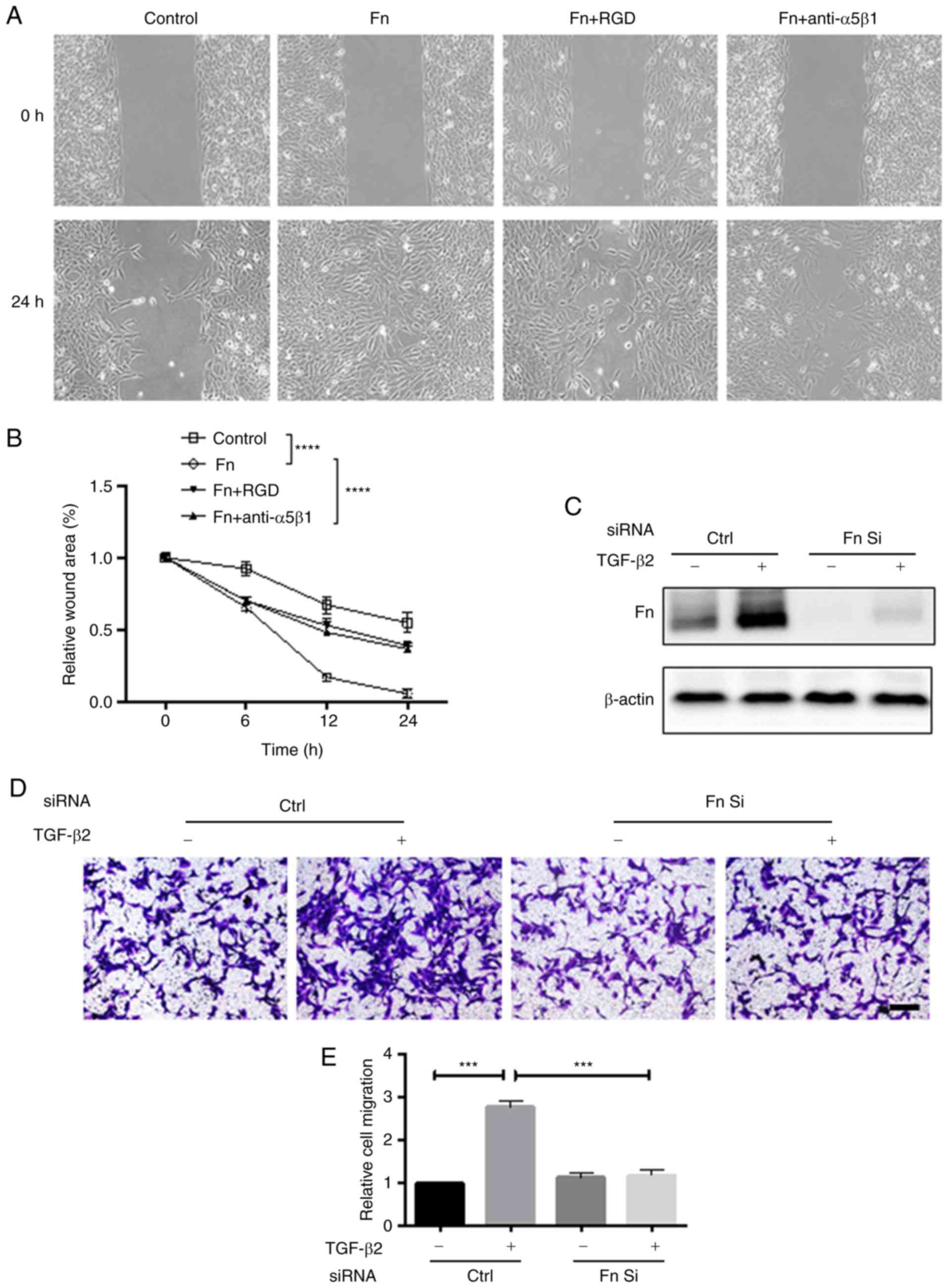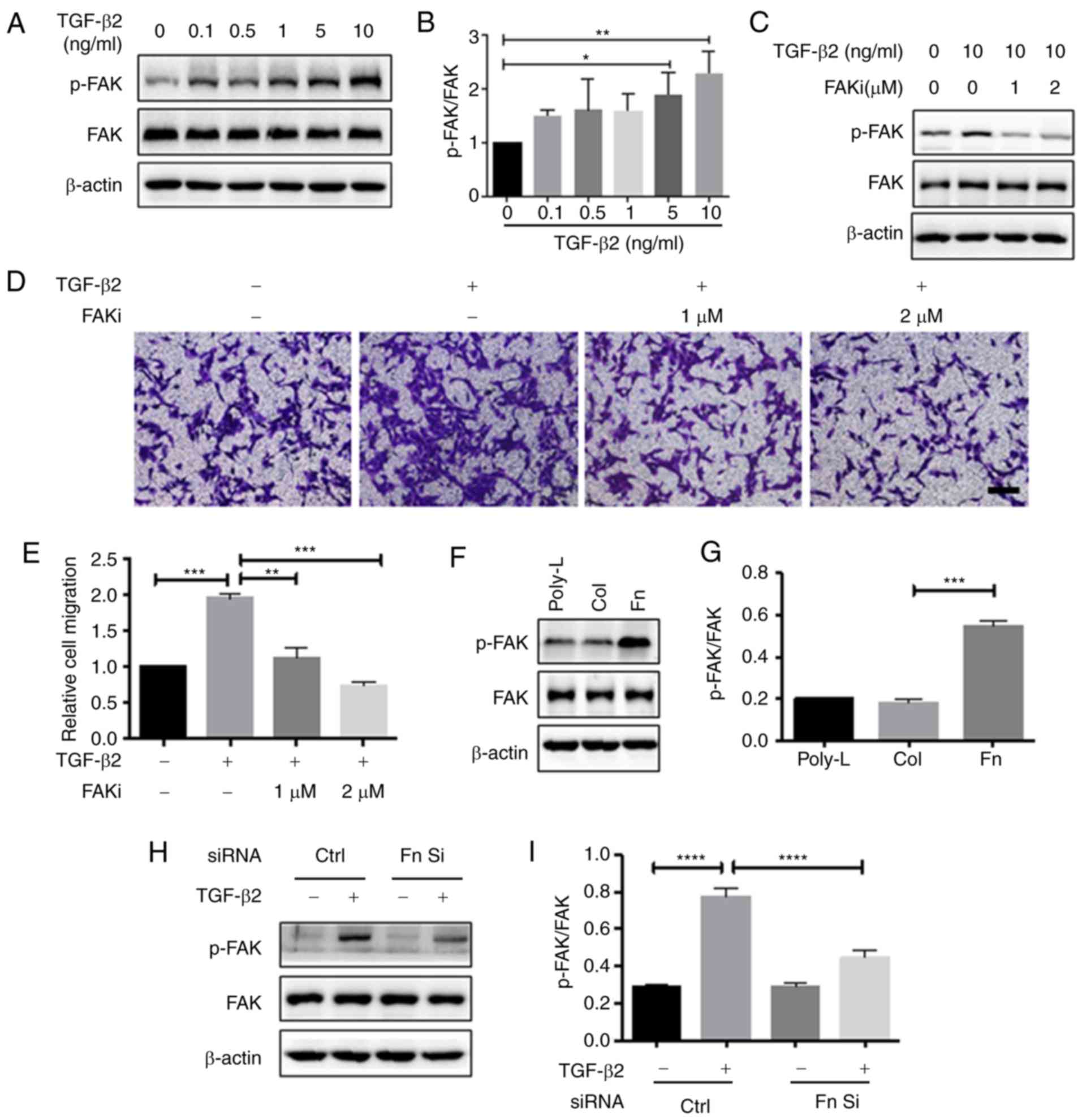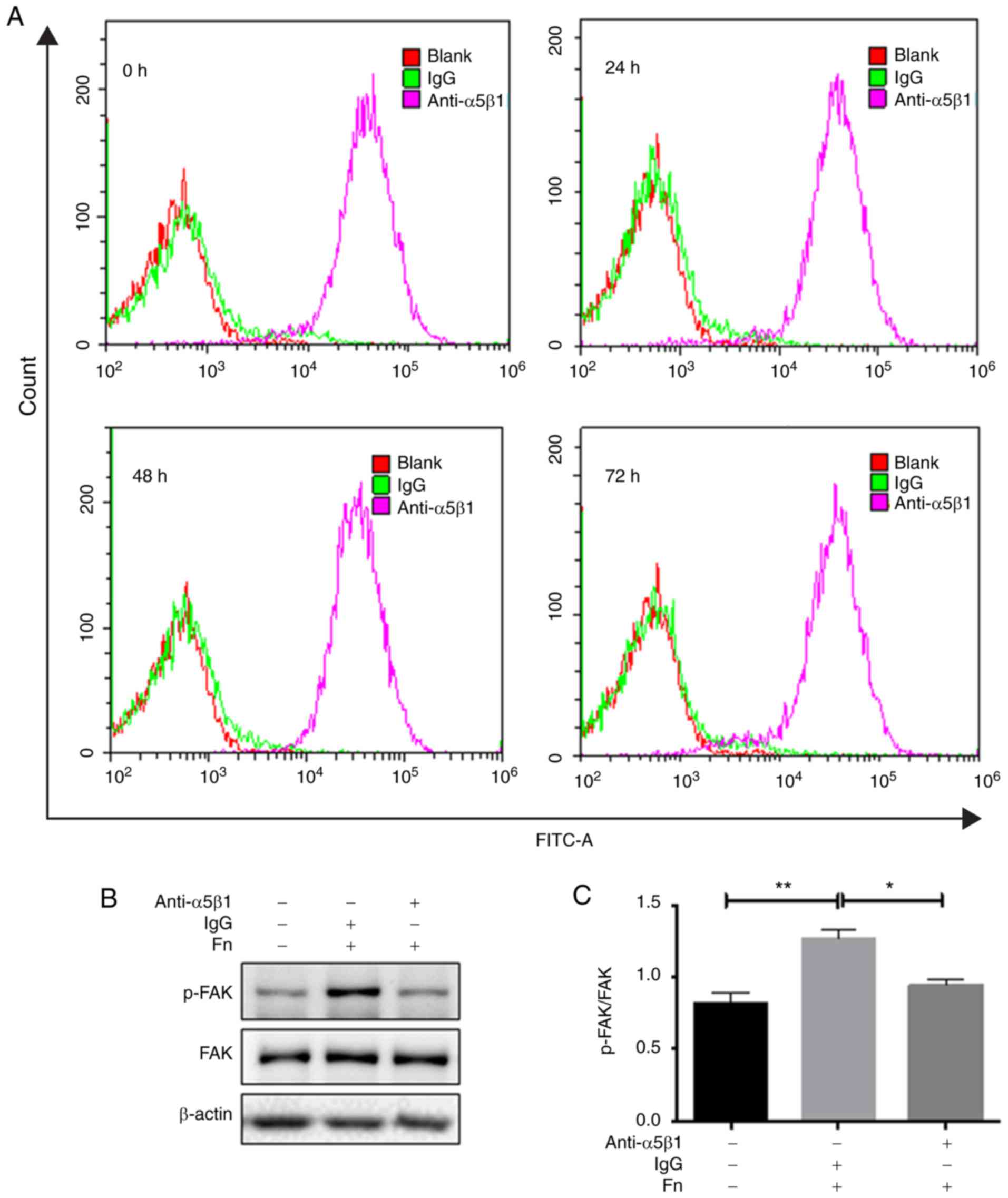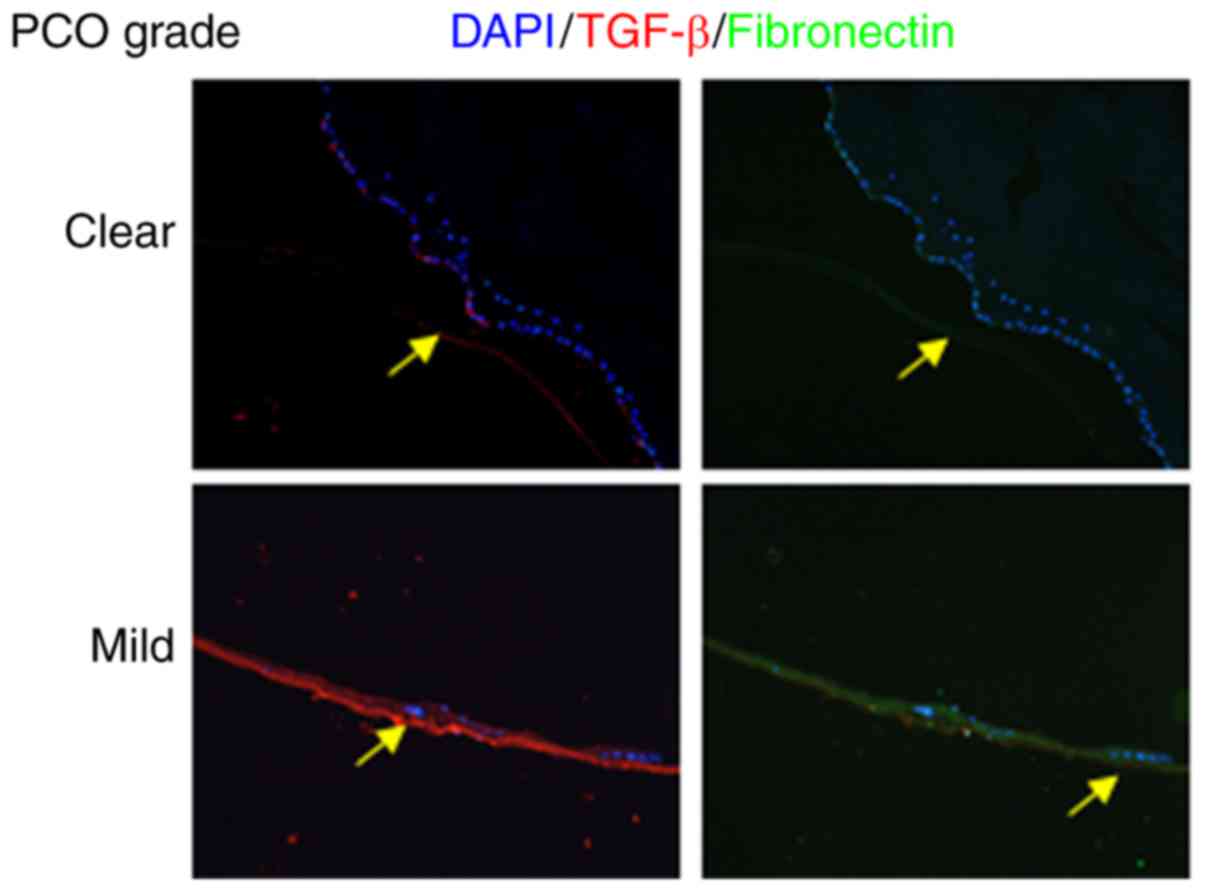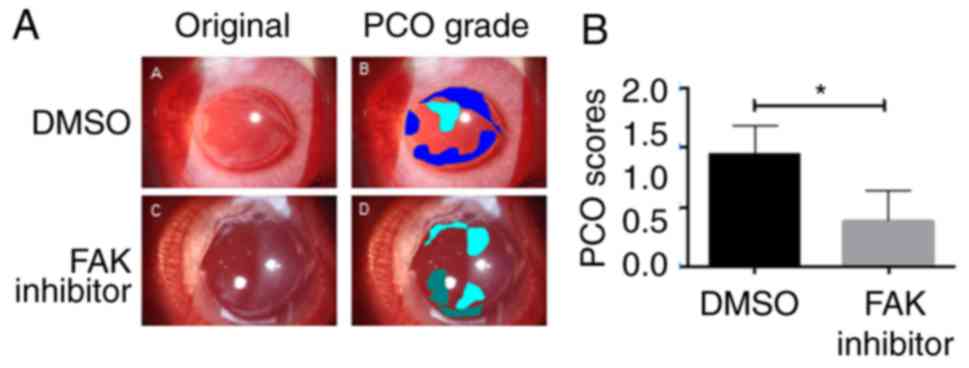|
1
|
Wormstone IM and Eldred JA: Experimental
models for posterior capsule opacification research. Exp Eye Res.
142:2–12. 2016. View Article : Google Scholar
|
|
2
|
Nibourg LM, Gelens E, Kuijer R, Hooymans
JM, van Kooten TG and Koopmans SA: Prevention of posterior capsular
opacification. Exp Eye Res. 136:100–115. 2015. View Article : Google Scholar : PubMed/NCBI
|
|
3
|
Kane CJ, Hebda PA, Mansbridge JN and
Hanawalt PC: Direct evidence for spatial and temporal regulation of
transforming growth factor beta 1 expression during cutaneous wound
healing. J Cell Physiol. 148:157–173. 1991. View Article : Google Scholar : PubMed/NCBI
|
|
4
|
Tan X, Zhu Y, Chen C, Chen X, Qin Y, Qu B,
Luo L, Lin H, Wu M, Chen W and Liu Y: Sprouty2 suppresses
epithelial-mesenchymal transition of human lens epithelial cells
through blockade of Smad2 and ERK1/2 pathways. PLoS One.
11:e01592752016. View Article : Google Scholar : PubMed/NCBI
|
|
5
|
Leask A: Potential therapeutic targets for
cardiac fibrosis: TGFbeta, angiotensin, endothelin, CCN2, and PDGF,
partners in fibroblast activation. Circ Res. 106:1675–1680. 2010.
View Article : Google Scholar : PubMed/NCBI
|
|
6
|
Munger JS and Sheppard D: Cross talk among
TGF-β signaling pathways, integrins, and the extracellular matrix.
Cold Spring Harb Perspect Biol. 3:a0050172011. View Article : Google Scholar
|
|
7
|
Varadaraj A, Jenkins LM, Singh P, Chanda
A, Snider J, Lee N, Amsalem-Zafran AR, Ehrlich M, Henis YI and
Mythreye K: TGF-β triggers rapid fibrillogenesis via a novel
TβRII-dependent fibronectin-trafficking mechanism. Mol Biol Cell.
28:1195–1207. 2017. View Article : Google Scholar : PubMed/NCBI
|
|
8
|
Scaffidi AK, Petrovic N, Moodley YP,
Fogel-Petrovic M, Kroeger KM, Seeber RM, Eidne KA, Thompson PJ and
Knight DA: Alpha(v)beta(3) Integrin interacts with the transforming
growth factor beta (TGFbeta) type II receptor to potentiate the
proliferative effects of TGFbeta1 in living human lung fibroblasts.
J Biol Chem. 279:37726–37733. 2004. View Article : Google Scholar : PubMed/NCBI
|
|
9
|
Galliher AJ and Schiemann WP: Beta 3
integrin and Src facilitate transforming growth factor-beta
mediated induction of epithelial-mesenchymal transition in mammary
epithelial cells. Breast Cancer Res. 8:R422006. View Article : Google Scholar
|
|
10
|
Margadant C and Sonnenberg A:
Integrin-TGF-beta crosstalk in fibrosis, cancer and wound healing.
EMBO Rep. 11:97–105. 2010. View Article : Google Scholar : PubMed/NCBI
|
|
11
|
Leask A: Focal adhesion kinase: A key
mediator of transforming growth factor beta signaling in
fibroblasts. Adv Wound Care (New Rochelle). 2:247–249. 2013.
View Article : Google Scholar
|
|
12
|
Thannickal VJ, Lee DY, White ES, Cui Z,
Larios JM, Chacon R, Horowitz JC, Day RM and Thomas PE:
Myofibroblast differentiation by transforming growth factor-beta1
is dependent on cell adhesion and integrin signaling via focal
adhesion kinase. J Biol Chem. 278:12384–12389. 2003. View Article : Google Scholar : PubMed/NCBI
|
|
13
|
Wormstone IM: Posterior capsule
opacification: A cell biological perspective. Exp Eye Res.
74:337–347. 2002. View Article : Google Scholar : PubMed/NCBI
|
|
14
|
Wormstone IM, Tamiya S, Anderson I and
Duncan G: TGF-beta2-induced matrix modification and cell
transdifferen-tiation in the human lens capsular bag. Invest
Ophthalmol Vis Sci. 43:2301–2308. 2002.PubMed/NCBI
|
|
15
|
Dawes L, Elliott R, Reddan J, Wormstone Y
and Wormstone I: Oligonucleotide microarray analysis of human lens
epithelial cells: TGFbeta regulated gene expression. Mol Vis.
13:1181–1197. 2007.PubMed/NCBI
|
|
16
|
Walker J and Menko AS: Integrins in lens
development and disease. Exp Eye Res. 88:216–225. 2009. View Article : Google Scholar :
|
|
17
|
Niwa Y, Kanda H, Shikauchi Y, Saiura A,
Matsubara K, Kitagawa T, Yamamoto J, Kubo T and Yoshikawa H:
Methylation silencing of SOCS-3 promotes cell growth and migration
by enhancing JAK/STAT and FAK signalings in human hepato-cellular
carcinoma. Oncogene. 24:6406–6417. 2005. View Article : Google Scholar : PubMed/NCBI
|
|
18
|
Choi I, Kim B, Byun JW, Baik SH, Huh YH,
Kim JH, Mook-Jung I, Song WK, Shin JH, Seo H, et al: LRRK2 G2019S
mutation attenuates microglial motility by inhibiting focal
adhesion kinase. Nat Commun. 6:82552005. View Article : Google Scholar
|
|
19
|
Hueng DY, Hsieh CH, Cheng YC, Tsai WC and
Chen Y: Cordycepin inhibits migration of human glioblastoma cells
by affecting lysosomal degradation and protein phosphatase
activation. J Nutr Biochem. 41:109–116. 2017. View Article : Google Scholar : PubMed/NCBI
|
|
20
|
Payne SL, Fogelgren B, Hess AR, Seftor EA,
Wiley EL, Fong SF, Csiszar K, Hendrix MJ and Kirschmann DA: Lysyl
oxidase regulates breast cancer cell migration and adhesion through
a hydrogen peroxide-mediated mechanism. Cancer Res. 65:11429–11436.
2005. View Article : Google Scholar : PubMed/NCBI
|
|
21
|
Zhao XK, Cheng Y, Cheng ML, Yu L, Mu M, Li
H, Liu Y, Zhang B, Yao Y, Guo H, et al: Focal adhesion kinase
regulates fibroblast migration via integrin beta-1 and plays a
central role in fibrosis. Sci Rep. 6:192762016. View Article : Google Scholar : PubMed/NCBI
|
|
22
|
Cicchini C, Laudadio I, Citarella F,
Corazzari M, Steindler C, Conigliaro A, Fantoni A, Amicone L and
Tripodi M: TGFbeta-induced EMT requires focal adhesion kinase (FAK)
signaling. Exp Cell Res. 314:143–152. 2008. View Article : Google Scholar
|
|
23
|
Cai GQ, Zheng A, Tang Q, White ES, Chou
CF, Gladson CL, Olman MA and Ding Q: Downregulation of FAK-related
non-kinase mediates the migratory phenotype of human fibrotic lung
fibroblasts. Exp Cell Res. 316:1600–1609. 2010. View Article : Google Scholar : PubMed/NCBI
|
|
24
|
Wang SE, Xiang B, Zent R, Quaranta V,
Pozzi A and Arteaga CL: Transforming growth factor beta induces
clustering of HER2 and integrins by activating Src-focal adhesion
kinase and receptor association to the cytoskeleton. Cancer Res.
69:475–482. 2009. View Article : Google Scholar : PubMed/NCBI
|
|
25
|
Kilkenny C, Browne WJ, Cuthill IC, Emerson
M and Altman DG: Improving bioscience research reporting: The
ARRIVE guidelines for reporting animal research. J Pharmacol
Pharmacother. 1:94–99. 2010. View Article : Google Scholar
|
|
26
|
Knesl O, Hart BL, Fine AH, Cooper L,
Patterson-Kane E, Houlihan KE and Anthony R: Veterinarians and
humane endings: When is it the right time to euthanize a companion
Animal? Front Vet Sci. 4:452017. View Article : Google Scholar : PubMed/NCBI
|
|
27
|
Ma B, Yang L, Jing R, Liu J, Quan Y, Hui
Q, Li J, Qin L and Pei C: Effects of Interleukin-6 on posterior
capsular opacification. Exp Eye Res. 172:94–103. 2018. View Article : Google Scholar : PubMed/NCBI
|
|
28
|
Camparini M, Macaluso C, Reggiani L and
Maraini G: Retroillumination versus reflected-light images in the
photographic assessment of posterior capsule opacification. Invest
Ophthalmol Vis Sci. 41:3074–3079. 2000.PubMed/NCBI
|
|
29
|
Raj SM, Vasavada AR, Johar SK and Vasavada
VA and Vasavada VA: Post-operative capsular opacification: A
review. Int J Biomed Sci. 3:237–250. 2007.PubMed/NCBI
|
|
30
|
Bainbridge P: Wound healing and the role
of fibroblasts. J Wound Care. 22:407–408. 410–412. 2013. View Article : Google Scholar : PubMed/NCBI
|
|
31
|
Guo R, Meng Q, Guo H, Xiao L, Yang X, Cui
Y and Huang Y: TGF-β2 induces epithelial-mesenchymal transition in
cultured human lens epithelial cells through activation of the
PI3K/Akt/mTOR signaling pathway. Mol Med Rep. 13:1105–1110. 2016.
View Article : Google Scholar
|
|
32
|
Tiwari A, Kumar R, Ram J, Sharma M and
Luthra-Guptasarma M: Control of fibrotic changes through the
synergistic effects of anti-fibronectin antibody and an RGDS-tagged
form of the same antibody. Sci Rep. 6:308722016. View Article : Google Scholar : PubMed/NCBI
|
|
33
|
Schaffner F, Ray AM and Dontenwill M:
Integrin α5β1, the fibro-nectin receptor, as a pertinent
therapeutic target in solid tumors. Cancers (Basel). 5:27–47. 2013.
View Article : Google Scholar
|
|
34
|
Rae J and Kuszak J: The electrical
coupling of epithelium and fibers in the frog lens. Exp Eye Res.
36:317–326. 1983. View Article : Google Scholar : PubMed/NCBI
|
|
35
|
Candia OA: Electrolyte and fluid transport
across corneal, conjunctival and lens epithelia. Exp Eye Res.
78:527–535. 2004. View Article : Google Scholar : PubMed/NCBI
|
|
36
|
Bleaken BM, Menko AS and Walker JL: Cells
activated for wound repair have the potential to direct collective
invasion of an epithelium. Mol Biol Cell. 27:451–465. 2016.
View Article : Google Scholar :
|
|
37
|
de Iongh RU, Wederell E, Lovicu F and
McAvoy J: Transforming growth factor-beta-induced
epithelial-mesenchymal transition in the lens: A model for cataract
formation. Cells Tissues Organs. 179:43–55. 2005. View Article : Google Scholar : PubMed/NCBI
|
|
38
|
Meng F, Li J, Yang X, Yuan X and Tang X:
Role of Smad3 signaling in the epithelial-mesenchymal transition of
the lens epithelium following injury. Int J Mol Med. 42:851–860.
2018.PubMed/NCBI
|
|
39
|
Schlötzer-Schrehardt U, Zenkel M, Küchle
M, Sakai LY and Naumann GO: Role of transforming growth
factor-beta1 and its latent form binding protein in
pseudoexfoliation syndrome. Exp Eye Res. 73:765–780. 2001.
View Article : Google Scholar
|
|
40
|
Ohta K, Yamagami S, Taylor AW and
Streilein JW: IL-6 antagonizes TGF-beta and abolishes immune
privilege in eyes with endotoxin-induced uveitis. Invest Ophthalmol
Vis Sci. 41:2591–2599. 2000.PubMed/NCBI
|
|
41
|
Wormstone IM, Anderson IK, Eldred JA,
Dawes LJ and Duncan G: Short-term exposure to transforming growth
factor beta induces long-term fibrotic responses. Exp Eye Res.
83:1238–1245. 2006. View Article : Google Scholar : PubMed/NCBI
|
|
42
|
Marcantonio J and Reddan J: TGFbeta 2
influences alpha5-beta1 integrin distribution in human lens cells.
Exp Eye Res. 79:437–442. 2004. View Article : Google Scholar : PubMed/NCBI
|
|
43
|
Yang C, Zeisberg M, Mosterman B, Sudhakar
A, Yerramalla U, Holthaus K, Xu L, Eng F, Afdhal N and Kalluri R:
Liver fibrosis: Insights into migration of hepatic stellate cells
in response to extracellular matrix and growth factors.
Gastroenterology. 124:147–159. 2003. View Article : Google Scholar : PubMed/NCBI
|
|
44
|
Parvani JG, Galliher-Beckley AJ, Schiemann
BJ and Schiemann WP: Targeted inactivation of β1 integrin induces
β3 integrin switching, which drives breast cancer metastasis by
TGF-β. Mol Biol Cell. 24:3449–3459. 2013. View Article : Google Scholar : PubMed/NCBI
|
|
45
|
Salvo E, Garasa S, Dotor J, Morales X,
Peláez R, Altevogt P and Rouzaut A: Combined targeting of TGF-β1
and integrin β3 impairs lymph node metastasis in a mouse model of
non-small-cell lung cancer. Mol Cancer. 13:1122014. View Article : Google Scholar
|
|
46
|
Kenny HA, Chiang CY, White EA, Schryver
EM, Habis M, Romero IL, Ladanyi A, Penicka CV, George J, Matlin K,
et al: Mesothelial cells promote early ovarian cancer metastasis
through fibronectin secretion. J Clin Invest. 124:4614–4628. 2014.
View Article : Google Scholar : PubMed/NCBI
|
|
47
|
Yoshino H, Enokida H, Itesako T, Tatarano
S, Kinoshita T, Fuse M, Kojima S, Nakagawa M and Seki N:
Epithelial-mesenchymal transition-related microRNA-200s regulate
molecular targets and pathways in renal cell carcinoma. J Hum
Genet. 58:508–516. 2013. View Article : Google Scholar : PubMed/NCBI
|
|
48
|
Huang CR, Lee CT, Chang KY, Chang WC, Liu
YW, Lee JC and Chen BK: Down-regulation of ARNT promotes cancer
metastasis by activating the fibronectin/integrin β1/FAK axis.
Oncotarget. 6:11530–11546. 2015.PubMed/NCBI
|
|
49
|
Weston BS, Wahab NA and Mason RM: CTGF
mediates TGF-beta-induced fibronectin matrix deposition by
upregulating active alpha5beta1 integrin in human mesangial cells.
J Am Soc Nephrol. 14:601–610. 2003. View Article : Google Scholar : PubMed/NCBI
|
|
50
|
Golubovskaya VM: Targeting FAK in human
cancer: From finding to first clinical trials. Front Biosci
(Landmark Ed). 19:687–706. 2014. View
Article : Google Scholar
|
|
51
|
Wang Y, Terrell AM, Riggio BA, Anand D,
Lachke SA and Duncan MK: β1-integrin deletion from the lens
activates cellular stress responses leading to apoptosis and
fibrosis. Invest Ophthalmol Vis Sci. 58:3896–3922. 2017. View Article : Google Scholar : PubMed/NCBI
|















